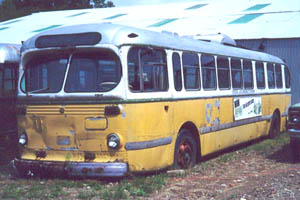
- Builder
- CCF-Brill
- Description
- Model T44A
- Secondary Use
- None
- Type
- Trackless Trolleys
- Year
- 1950
- Retired from Service
- 1971
- Acquired by the Museum
- 1971
- Note
- No. 273 is stored outside Central car barn. It is in fair condition and in need of various repairs.
- Fund
- 693
Nova Scotia Light & Power Co. 273
From Halifax, Nova Scotia
History
After World War II, Nova Scotia Light & Power (NSL&P), which ran the transit system in Halifax, decided to convert its entire streetcar system to trolley bus operation. These vehicles can also be termed “trackless trolleys” or “trolleycoaches” which was the term used in Halifax. Trolley buses have some advantages as transit vehicles. They can accelerate and brake better than motor buses, and they have no exhaust and are almost silent. They are the best transit vehicles (aside from cable cars) for climbing and descending steep hills. A downside for trolley buses is their two overhead wires (thought by some to be unsightly) which are required to complete the electric circuit unlike streetcars which use rails for the return current. More importantly, until the 1990s, trolley buses were restricted to streets with the overhead wires. Since then, all newly manufactured trolley buses are equipped with auxiliary battery power which allows them to bypass streets undergoing construction and to extend service beyond the end point of the overhead wires. In the 1950s and 1960s, most North American transit operators replaced trolley bus routes with more versatile motor buses.
NSL&P had considered modernizing the street railway, but important negatives were the narrow streets and sharp turns – the very reason that its entire fleet was limited to 82 short wheelbase, 4-wheel Birney trolleys. Following a detailed analysis of future trends, a Toronto consultant advised trolleycoaches as the best solution to handle an expected 50 percent increase in patronage. The carefully-crafted conversion took place over a four-month period between March and July of 1949. Installation of the new trolleycoach wires was initially concentrated in downtown Halifax and Barrington Street, resulting in trolleycoaches working the city center portion of most routes while the Birney trolleys continued to temporarily work the outer portions. The final streetcar journeys took place on March 26, 1949, and in so doing, Halifax became the first city in North America whose transit system was exclusively trolleycoach – with not a single auxiliary motor bus.
The initial trolleycoach fleet comprised 71 Canadian Car & Foundry (CCF) 44-seat model T44 coaches shipped aboard railroad flatcars from the CCF plant in Fort William (now Thunder Bay), Ontario. Numbered 201-271, all had arrived in Halifax by early 1949. Additional purchases brought four T-44A’s in 1950 (272-275) and two more in 1952 (276 and 277). Another four were required in 1954 (278-281) due to the opening of the new cross-harbor Angus MacDonald suspension bridge to Dartmouth. Anticipating continued growth in patronage, these were followed in 1955 by the surprising purchase of six 1947 Pullman-Standard 44CS trolleycoaches from United Transit Co. of Providence, Rhode Island. Because Halifax is concentrated on a peninsula with only a narrow connection to the mainland, trolleycoaches were well suited to serve the dense housing and commercial areas. With few changes, ten trolleycoach routes with frequent headways continued to serve Halifax for two decades.
Altogether, between 1946 and 1954, CC&F – later known as Can Car – built 1,114 trolley buses for Canadian operators, following designs licensed by American Car & Foundry (ACF-Brill.)
In 1963, Nova Scotia Light & Power bought a dozen Canadian-built GM TDH4519 diesel buses which were assigned solely to a pair of entirely new routes, the 8 and 10, largely serving new residential neighborhoods and shopping centers. However, during the 1960s, deficits, small at first, increased every year rising to $105,097 in 1965. And by then, serious traffic congestion was hindering and delaying trolleycoach service. With nearly all land on the Halifax peninsula occupied, housing tracts began to appear in neighboring communities, resulting in their annexation into the City of Halifax. Terms of its franchise required NSL&P to serve the entire city, creating an impossible problem for trolleyoach operation. The situation led to the formation of a city-owned transit commission – Halifax Transit. With an entirely new fleet of diesel buses (and the twelve diesel buses ex-NSL&P), the new regime took over on January 1, 1970. The last trolleycoach, No. 243, pulled into the Young Street garage at 12:43 AM on New Year’s Day – the final goodbye to a highly respected and well managed trolleycoach transit system.
After the municipal takeover, Nova Scotia Light & Power sought buyers for its newly idle trolley buses. All were scrapped aside from No. 273 and a few sold to individuals for use as cabins and storage sheds. In response to a request from Seashore, NSL&P donated trolleycoach No. 273 to the museum. This was the only Halifax trolleycoach to be preserved. No. 273 became part of the museum’s extensive collection of Canadian transit vehicles – the largest outside of Canada. Within Seashore’s Canadian collection, No. 273 is the only representative from the Maritime Provinces.
In 1971, No. 273’s trip to the museum started by truck from Halifax to Yarmouth, Nova Scotia. From Yarmouth to Portland, ME, No. 273 rode on the ferry MS Prince of Fundy. The ship’s owner, Lion Ferry, donated the transportation on the ferry. From Portland, a Biddeford & Saco Bus crew towed No. 273 to Kennebunkport.
No. 273 was the fourth trolley bus at Seashore, and was an impetus for the museum to construct overhead wires to operate these vehicles.
Technical Information
- Seats: 44
- Control: MRC
- Brakes: Straight Air
- Tires: 11x20
Motor
- Number: 1
- Manufacturer: General Electric
- Model: 1213
Weight and Dimensions
- Length: 35’ 3.00"
- Width: 8’ 6.00"
- Height: 10’ 6.00"
© 1998 - 2025 New England Electric Railway Historical Society. All Rights Reserved.